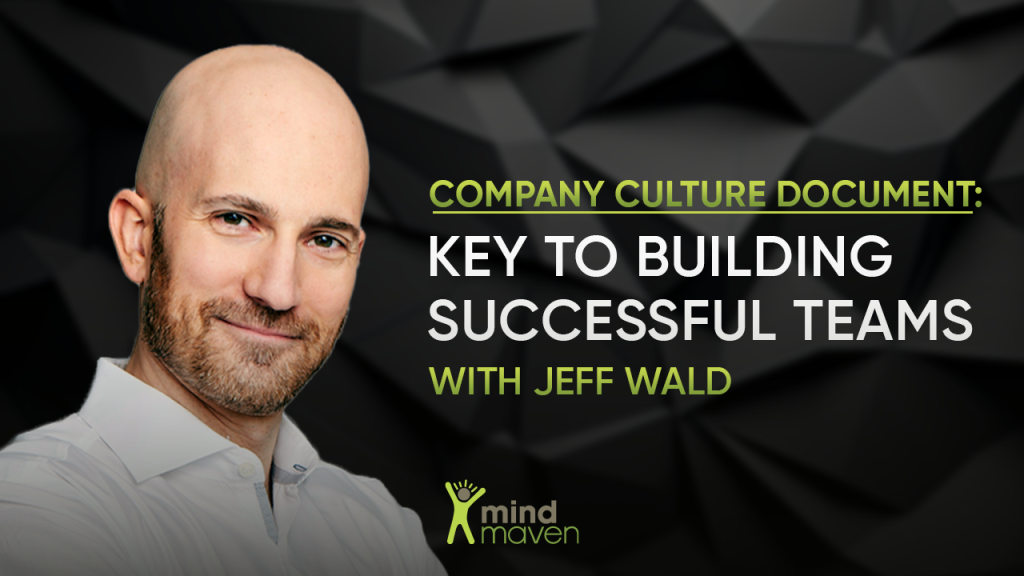Welcome back to our series on the benefits of company culture, where we continue our discussion with Mindmaven Founder and CEO Patrick Ewers and serial entrepreneur Jeff Wald.
In Part 1, Patrick and Jeff laid the groundwork on how to create a living company culture document that propels your operations toward your collective North Star.
(Not caught up? Click here to read Part 1 of this session now.)
Now, in Part 2, we dive deeper into the benefits of company culture and why creating a culture document is key for building aligned, productive, and successful teams.
Keep reading to discover why this is not only critical to achieving your organizational goals but is also a more humane way of leading.
What Are The Benefits of Company Culture and Transparency In Leadership?
Jeff shares the benefits of company culture, including how prioritizing transparency not only attracts the right followers but also enhances communication and mutual understanding within your team.
Jeff: “I think it’s important that you are very clear and intentional about the kind of company you want to build. So, as a leader, we get the followers we deserve.
And if you’re not really clear with everybody, then that’s going to be the team you’re going to get. People aren’t going to be clear with each other.
If you are being intentional, not only will you get the team you deserve, and everybody understands, but people opt in and opt out.
Post-acquisition, when that document was then up on our website, if you applied to join WorkMarket, it said, ‘Please read our culture document before you come.’
There was a page in that culture document that says, ‘This is what we expect of a WorkMarket employee. This is what we expect of a WorkMarket manager.’
We’re very open. We like constructive criticism and collaboration. That’s not for everybody – and if it’s not for everybody, everybody’s better off.
You, your team, that person is better off in a different organization, in a different culture.
If you’re not clear about it, you’re just less likely to uncover it. You’re less likely to course correct, and you’re less likely to be successful.”
Patrick adds: “If we take this concept of just the impact on the team, it starts with people being able to self-select themselves into your organization when they’re going through a hiring process.
It is either what they want to do or not. But if they do choose to come and work with you, they do it because they have a connection to what you’re offering. That is a much stronger basis of joining.
I would say for your organization, those people that self-select into it become better employees, and become more productive members of the team.”
How To Create Team Alignment Toward Your North Star
Patrick explains: “I think it was very important to point out that you not only have the document and it collects dust somewhere, you make it become alive weekly, if not daily.
To me, it’s the tip that I always give to my clients:
If your employees are not throwing up hearing something, you are not doing your job as a leader.
But the neat thing that you get from that is alignment. Alignment is a gift to the team because it means they will feel like they can work with less friction, with less conflict.
The arguments that usually would arise don’t arise because what you are doing is aligned with what everybody has to be doing, and it’s easier to agree with each other.
When you do that, you are giving a huge gift of success to people because you are actually becoming more productive.”
Jeff: “I would say it’s not only easier to agree, it’s easier to disagree.
‘Wait, guys, does this align to our North Star? Because this doesn’t seem to be helping us get there, so maybe this isn’t the best idea.’
And everyone goes, ‘Oh, you’re right, actually, this would take us a little …’
‘No, we’re supposed to go this way, but this would take us this way.’
Good push, good counter. Easier to do that if we’re all aligned on that North Star, then we can agree to go there. But we can also disagree with actions that aren’t helping us get there.”
Patrick concludes: “It becomes almost like a constitution upon which we can regulate what and how we make decisions.”
How To Bring Your Company Culture To Life
If you wish to experience the benefits of company culture within your organization, it takes more than just words on paper; it requires action.
So, how do you actually breathe life into your company culture document day in and day out?
Patrick uncovers the real-life tactics Jeff uses to ensure the benefits of company culture aren’t just theoretical but a daily lived experience.
Jeff: “Well, it obviously depends on what your culture is. For us, transparency is very important.
For us, learning and development is very important, so every single team’s got their quarterly goals.
Then, every manager has how their individual performers are going to ladder up to those quarterly goals because when their team hits their goals, then the company can hit their goals.
But as a part of that conversation is, what kind of learning and professional development are you going to do?”
The Importance of SMART Goals
Jeff: “That is a very important part of our culture. Therefore, in every conversation that a manager is having with their employees, with their team members, they’re going to not only outline what the KPIs are that they need to achieve …
But, it is also going to be up to the employee to put in two or three professional development goals that they want to achieve by the end of the quarter.
And it’s important that we operate on smart goals:
- Specific
- Measurable
- Action-oriented
- Relevant
- Time-based
Example: SMART Goals
Jeff: “I had my A VP of Finance at WorkMarket said, ‘I want to be a better public speaker.’
And I said, ‘Liz, I don’t know what to do with that. That can’t be your goal. What are some SMART goals that ladder you to that?’
What was I supposed to do, right at June 30th, be like, ‘Liz, check! You are a better public speaker than you were three months ago.’ I can’t do that. It’s a judgment.
But I could say, ‘Liz, have you joined Toastmasters? Because you have until June 30th to join Toastmasters.’
‘Great. Have you given two talks to groups greater than ten?’
‘You gave one? Great. You’ve got another six weeks to get another one done. How can I support you in getting that done?’
That’s my job as the manager to support her and her professional development goals. But I need to understand what they are, and they should be codified within their OKRs, the same way any other kind of work goal is codified there because that’s a part of our culture.
So that is something that is in that culture document. Every person will have two to three professional goals per quarter.
There will be smart goals. It says it in there, and then it comes to life in here. But if it’s not happening, that’s a big problem.”
The Importance of Authenticity in Your Company Culture Document
In order to see the benefits of company culture, you need to show commitment – not just in words but in actionable policies.
Jeff explains: “If you have a value, and then you don’t articulate what are the policies or behaviors that support that value, then you don’t have that value.
For us, putting those professional development goals into those KPIs or OKRs, quarter by quarter, is a very important policy. It is a thou shalt.
Put two to three professional development goals in your document to be discussed with your manager once a week.
We do that because it supports our values. If people start not doing it, then do we value that? The answer is really no.
If I find that a manager isn’t doing that, I will sit down with the manager and walk me through. ‘Why are you not doing this? This is a value of ours. This is a behavior that supports that value.’
Sometimes, the manager goes, ‘It’s just not that important to me. I just want to hit my numbers.’
‘Okay, this isn’t the right place for you.’
That’s how that conversation has to go.
Or, change the culture document because that is not something you value, and the thread that runs through that is authenticity.
If you say something but do something else, you will get the team you deserve.”
The Importance of Showing Your Team You Care
In this session, we’ve explored the importance of creating an authentic company culture document and the benefits of company culture you can expect to see.
For Jeff, a significant component of this is ensuring that management and leadership on-to-ones help people achieve growth. Patrick and Jeff dive deeper into why they believe this is such a powerful thing to do.
Patrick: “If somebody is feeling he’s working in a place where the company cares about them and is actually giving them an environment in which they have that experience of growth …
And if you want people working for you that enjoy the experience of growth, you will actually create an environment for them that feels really right for them, really healthy.
You probably can rely on two things:
- They will work harder, and
- They will stick around longer.
Both are things that actually are really critical for a startup to succeed.”
Jeff: “I do love this great saying:
People won’t care how much you know unless they know how much you care.
And so, my employees know that I care about them. I care about their professional development; I care about their personal development.
Does that mean that they’re going to work harder for me? I honestly don’t know.
That’s the way I want to live my life.
I get such incredible joy out of leading this organization and any other organization that I’ve led because it attracts the kind of people I want to spend my time with. They’re smart, they work hard, they want to learn, they want to grow.
As I think about attracting other people to this team, and to any team I build, I want people like that on my team – and I’m only going to get them if they know how much I care.”
Next Steps: Access Your Free Guide To Creating a How I Work Document
Ready to increase communication and transparency within your team?
Our How I Work Notion template is designed exactly for this purpose. Acting as a leadership user manual, it helps you clearly articulate your values, decision-making styles, communication preferences, and expectations.
This not only accelerates the understanding of your leadership style across the team but also sets the stage for improved productivity and smoother collaboration.
With this tool, you can empower your team to move confidently towards your organization’s North Star goals.
Access your free template now to start building a more cohesive and efficient team:


